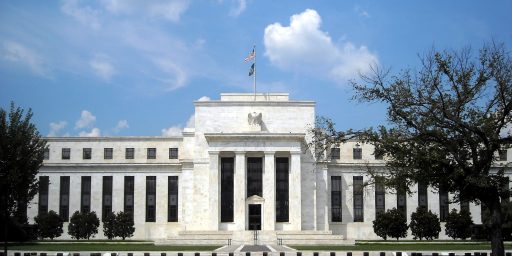Expect Greenspan and the Fed to Raise Interest Rates
Since the Bureau of Labor Statistics is reporting a 0.5% increase in the CPI for July.
WASHINGTON (MarketWatch) — Soaring energy prices pushed the U.S. consumer price index up 0.5% on a seasonally adjusted basis in July, the Labor Department said Tuesday.
Excluding food and energy prices, however, the core CPI increased a tame 0.1%.
The report leaves the Federal Reserve on course to raise interest rates again by a quarter percentage point in September, economists said.
Also, inflation has accelerated,
In the past year, the CPI has risen 3.2%, up from 2.5% on a year-over-year basis in June. The year-over-year gain in the core rate ticked a tenth of a percent higher to 2.1% in July.
The article notes that this is still within the Federal Reserves “comfort zone”, but that it will also mean further increases in interest rates.
The BLS CPI Summary can be found here. CNN has this article, and notes the following about energy prices,
A 14.2 percent rise in energy prices over the past 12 months, including a 3.8 percent increase in energy prices in July, was responsible for much of the increase in overall prices.






Mr. Greenspan is the end of Fed Fund raises…
Is the global economy at the brink of a breakdown much greater than its predecessor in 1929? How do the current imbalances compare to those late Roaring Twenties’ similar circumstances of consumer-level forward consumption, debt, overvaluation of assets, and industrial overcapacity? Will the devaluation and asset decay process at the end of the second 70 year sub-fractal – contained within the 140 year Second Grand Fractal cycle beginning in 1858 – be greater than at the end of its first 70 year sub-fractal?
A chicken in every pot and two cars in every garage has been replaced with eating out three of seven nights at the plethora of fast food and dining opportunities that ‘froth’ the highways and typify the service type of economy the States have become. Three SUV’s and a Hummer distributed between a primary residence and an investment residence have superseded the two cars in a garage. Buy a radio or washer on credit has been bested with buy and buy with abandon everything imaginable with ubiquitously facilitated debt from refinanced or second mortgages based on the surety of ever appreciating house prices -the latter caused in part by fed fund rates 1/4 of the rates in 1928.
The evenly balanced declining and increasing annual GDP growth rates prior to 1929 have been replaced with continuous positive annual GDP’s growth rates during the past 45 years. The great creditor nation status of 1929 has been substituted with a beggar man debtor bravado country wearing only the emperor’s new clothes. Its treasury is writing bad checks against future income that can only be guaranteed if the remaining 57 percent of the US private (nongovernmental) work force becomes governmentalized allowing a Weimar type of hyperinflation. In short the consumer saturation point of 1929 looks very appealing against the very poor economic hand that America now holds. Consider America’s current financial balance sheet and thereafter consider how badly the unbalanced excesses of 1929 unfolded.
In the next nine weeks, data – which has always been there – will be re-recognized. GM’s and Ford’s junk bond status and their probability of default on a collective 450 billion dollars of debt will reappear. The thousand mirrors that reflect a single dollar in the derivatives markets will have key reflecting glasses broken erasing the image in 925. The housing bubble, that is so historically remarkable in its uniqueness in that virtually all know it to be a bubble, will crack. The microcosm of forward consumption in the last two months of the American auto business will witness the expected necessary microcosm of historically poor follow-on monthly sales. Major airlines will throw in the towel declaring bankruptcy and pension amnesty. Declining monthly GDP will receive attention. The real position of the individual debtor and the debtor country in the face of declining asset valuations and projected tax revenues will get its due. Fiscally impossible city and state governmental pension funds whose futures are tied to the equity markets and escalating real estate property values will have a viability reality check. For the first time in many years the concept of consumer retrenchment will be seriously and widely explored as a probable scenario.
The comparative initiating decay fractals at the secondary summit, with respect to March 2000, of US equity indices suggest a very remarkable primary revaluation. Watch the general trend and descent of the long term US note and bond debt markets as exiting money from equities and commodities flows into these long term debt instruments driving their interest rates lower. Gold has potentially only one more week before completing its maximal 12/30/30 weekly growth cycle with an abrupt devaluation. Opposite to gold, the dollar will transiently trend well. Expect the unexpected. Within this quantum fractal decay process, expect nonlinearity. Gary Lammert http://www.economicfractalist.com/ “